Manuscript accepted on :June 24, 2008
Published online on: --
Plagiarism Check: Yes
J. K. Makpo
Department of Biological Sciences, Nasarawa State University, Keffi (Nigeria).
Abstract
This study investigated the survival and pupation of Simulium hargreasvesi larvae under three contrasting gradients and current velocities in the laboratory. S. hargreavesi larvae exhibited higher pupation success in the highest gradient of 420 and current velocity of 46.6 cms-1 with a mean survival index of 291.5 while the mean survival index at lowest gradient of 00 with a current velocity of 13.6 cms-1 was 199.8. These suggest that high current velocity and gradient are more conducive for survival and pupation as indicated by accelerated development under these conditions. It is apparent that high gradient and water current velocity favour the development of the blackly larvae in the laboratory. These observations can be useful in developing fly control strategies for this onchocerciasis vector which has been a scourge of humans in Africa.
Keywords
Variations; pupation; Simulium hargreavesi; gradients; current velocity
Download this article as:| Copy the following to cite this article: Makpo J. K . The Performance of Simulium Hargreavesi Larvae Reared Under Three Contrasting Gradients and Current Velocities. Biomed Pharmacol J 2008;1(1). |
| Copy the following to cite this URL: Makpo J. K . The Performance of Simulium Hargreavesi Larvae Reared Under Three Contrasting Gradients and Current Velocities. Biomed Pharmacol J 2008;1(1). Available from: http://biomedpharmajournal.org/?p=213 |
Introduction
Simullids are ubiquitous flies, occurring in wide range of geographical areas where there is running water of sufficient permanence that can support the larval stages. Wilson et al (2002) reported that blackflies can occur at very localized sites even in hot deserts where natural water courses or irrigation channels exist, and that some species survive in the melt-water below glaciers, but at very high latitudes the number of species is small and blood-sucking species few or non.
The immature stages (larvae and pupae) are generally found in fast flowing fresh water courses ranging from the merest temporary trickles to the greatest rivers, though each species tends to prefer one particular type of habitat or the other. This type of distribution has been explained on the basis of high oxygen concentration (Post and Crosskey, 1985) as it especially affects the pupae and current speed (Awadzi et al 2004). Blackfly populations have been reported by Krueger(2001),Wilson et al (2005) and others,from various parts of Nigeria, including the Jos Plateau, about 30000 meters above sea level and parts of Nasarawa State. Their roles as vectors in the transmission and maintenance of the nematode infection, onchocerciasis with its medical and economic implications in tropical Africa have been enumerated (Hadis et al, 2005 and Usip et al, 2006).
Materials and Methods
Samples of the blackfly S. hargreavesi larvae were collected from the upper course of River Assob at the fringes of the Jos Plateau about 64km along Jos-Akwanga Road. The river is characterized by fast current velocity, small branching channels, ripples and pools and a rocky bed. The larvae were found mainly on trailing vegetation, submerged rocks and dead leaves in fast-flowing parts of the rivers with current velocity ranging from 1 to 2.6ms-1.
The sampling area was divided into upper (U), Middle (M) and lower (L) courses characterized by mean flow rates of 1.3m/s, 1.1 m/s and 2.6m/s respectively. The average depths were 44cm, 33cm and 28cm in that order.
Samples were collected into polythene bags and transported to the laboratory while still attached to the substrates. Identification and separation of the larvae into different species were carried out in the laboratory immediately on arrival from the field. Three different species were identified during this study namely: S. cervicornutum, S. vorax and S. hargreavvesi.
Breeding was carried out in an aquatron, which consisted of a continuous water circulation system comprising an elevated water tank from which water flowed through a fine filter into three taps. Water was then tapped from one of the three taps into an aquatron designed to accommodate three rearing tubes at three contrasting gradients of 00, 200 and 420. The water inlet was by a main delivery line branching off at appropriate points corresponding to the gradients. The current velocities for these gradients were 13.6cms-1, 25.8cm/s ad 46.5 cm/s respectively.
The rearing tubes had an equal bore diameter of 1.23cm while the aquatron was 31cm by 42cm in size.
A Gessner current meter was used to measure the water current velocity in cms-1. Three groups comprising a specific number of larvae per group were reared under three contrasting gradient and velocities. S. hargreavesi larvae were attached to three polythene strips and one strip was introduced into each of the three tubes in the aquatron. The water delivery tap was then opened slowly to allow the larvae get attached to the polythene firmly to avoid washing them off.
The larvae were fed with a suspension of algae collected from an artificial pond, centrifuged and introduced at the inflow part of the circulating water using a hypodermic syringe.
Temperature and other physico-chemical parameters such as dissolved oxygen, PH., conductivity and turbidity were monitored twice daily. Water was taken at5 the inflow and out flow points to monitor these physico-chemical parameters which are important to the survival of the flies. Records of the parameters were taken using a Horiba Model U-7 water checker.
Data were obtained on: (a) duration of pupation (b) number of larvae surviving after each day (c) emergence of pupae to imago at the three contrasting gradients and current velocities.
Results
The data on water quality characteristics monitored in the study are shown on table 1. The data indicate variation in dissolved oxygen (DO) levels due to temperature changes.
The table shows decreasing percentage DO differential with increasing temperature. This is as a result of the little amount of oxygen, which dissolves as temperature goes higher. The PH value does not seem to vary much as can be seen from the data.
Observations on survival and pupation at the three gradients are presented on table 2. The survival index is higher at 420 with current velocity of46.6 cms-1 which has mean percentage survival of 291.5 while the lowest gradient (00 ) with current velocity of 13.6 cms-1 has mean percentage survival index of 199.8.This result shows that the highest gradients of 420 better enhanced pupation than the lowest gradient 00 which had the lowest pupation value.
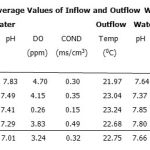 |
Table 1: Average Values of Inflow and Outflow Water Parameters
|
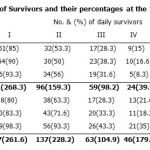 |
Table 2: Number of Survivors and their percentages at the three gradients
|
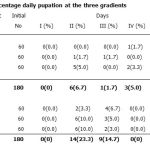 |
Table 3: Percentage daily pupation at the three gradients |
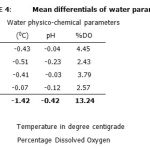 |
Table 4: Mean differentials of water parameters
|
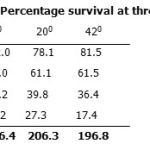 |
Table 5: Percentage survival at three gradients
|
Discussion
Observations of water quality in the three gradients indicated less DO at high temperatures and more at lower temperatures. This is because more oxygen dissolves at lower than at higher temperatures. It was also noted that there were little variation in pH and conductivity values. pH value remained at 7±1 throughout the period of the experiment. This confirms little variation in the water condition from sometimes acidic to neutral and alkaline water. The little variation observed could be attributed to the waste products from the larvae and other organisms that are in the rearing water, which could not be filtered out completely. On the changes in conductivity levels, there is a probability of up-take and out-put of ionized salts by the larvae. Most of the parameters monitored in the laboratory during this experiment showed more or less similar conditions with that of the natural habitat of this blackfly, Simulium hargreavesi. Mbah et al (2003) reported that different blackfly species had differences in their breeding sites with regards to the chemical composition of water especially with regard to pH and conductivity.
The larvae survive better at the highest gradient of 42 o with the current velocity of 46.6cms-1. This observation can be attributed to the availability of Oxygen in fast flowing water current as reported by Awadzi et al (2004). This also explain the preference of the fly larvae for fast flowing fresh water courses in streams, springs or rivers as Wilson et al (2002) observed. Table 4 shows negative temperature and PH values due to the fact that the temperature of inflow water was lower than outflow water because of the temperature regulation using a heater in the aquatron. The mean percentage survival showed an increase in value with increasing gradient, but decreased progressively with the numbers from day one to five, (Table 2). Survival was found to decrease with increase in time from the commencement of each experiment. Pupation was observed to occur during the first 4-5 days. The results show that transition from larvae to pupae was better at 420 than at 00 and 200. This could be attributed to the important effect of oxygen on the development of the blackfly larvae as earlier mentioned.
It was observed that the highest gradient did better in enhancing both survival and pupation. This is probably as a result of the fact that blackfly larvae occur in fast flowing water with reasonably high current velocity and favorable conditions for adequate oxygen up-take by the larvae. Therefore, since the flow rate at the 420 gradients was higher and probably more conducive for other physiological need of the larvae, it follows that the larvae did better in survival and transition at that gradient. Mbah et al (2003) observed that there was increase in feeding rate going from the slowest current to the highest. They reported a curvilinear relationship between feeding and current velocity that is once an optimum velocity is reached, increased current interferes with the feeding process. Mafuyai et al (2004) reported that current speed is more important than oxygen concentration in governing the distribution of larval blackflies; and that larvae prefer water with a velocity of 50 to 120 cms-1; the greater number occurring between 80 and 90 cms-1. The value of 46.6 cms-1 was therefore a better flow rate to the other two at 00 and 200, and therefore there was better survival and pupation at this gradient. The use of a water pump to maintain a continuous water circulation consequently favoured survival and perhaps increased the efficiency of food intake by the larvae. Since food particle capture is enhanced by fast flow rates, this result is apparent. Colbo and Porter (1981) suggested that the quantity of digestible material and not the amount of organic particles of ingestible size in water, which may not be correlated directly with nutritional value, should be measured.
However, further work need to be done on the effects of temperature and survival with relation to the habitat of this species under controlled rearing conditions. This will provide further information on the ecophysiology of these medically important dipterans.
References
- Awadzi K., Attah S. K., Addy E. T., Opoku N. O., Quartey B. T., Lazdins-Helds J.K., Ahmed K., Baotin B. A., Boakey, and G. Edwards., (2004). Thirty-month followed-up of sub-optimal responders to multiple treatments with ivermectin, in two onchocerciasis – endemic foci in Ghana. Annals of Tropical Medical Parasitology 98(4): 359-370.
- Hadis M., Wilson M. D., Cobblah M., and Boakey D.A., (2005). Cytotaxonomic description of Simulium kaffaense, a new member of the S. damnosum complex (Diptera: Simulidae) from South-Western Ethiopia. Annals of Tropical Medical Parasitology. 99(3): 267-291.
- Krueger, A. (2001). Guide to blackflies of the Simulium damnosum complex in Tropical Africa. Medical and Veterinary Entomology 20(1): 60-75.
- Mafuyai, H. B., Philips A., Molyneux, D. H., and Milligan, P. (1994). Identification of Larvae of the Simulium damnosum complex from Nigeria by analysis of Cutiular hydrocarbons. Tropical Medical Parasitology 45(2): 130-132.
- Mbah, C.E., Nock, I.H., and Vajime, O.G., (2003). Laboratory rearing and distribution of the breeding sites of Simulium species in Kaduna state. Journal of Aquatic Sciences 18(2): 131-140. Post, R.J. and Crosskey, R. W. (1985). The distribution of the Simulium danmnosum Complex in Sierra Leone and its relation to onchocerciasis. Annals of Tropical Medicine and Parasitology. 79(2): 169-194.
- Usip, L.P.E., Udonsi, J.K., Ibanga E.S., and Opara, K.N., (2006). Survey of breeding Sites and variation of Simulium damnosum in Ini L.G.A., Akwa Ibom State, Nigeria. Journal of Parasitology 24:149-154.
- Usip, L.P.E., Opara, K.N., Ibanga, E.S and Atting, I.A. (2006). Longitudinal Evaluation of repellant activity of Ocimal gratissim (Labiatae) volatile oil against S. damnosum. Memorias do lastituto Oswaldo Cruz 101(2): 201-205
- Wilson, M.D., Osei-Atweneboana M.Y., Boakey, D.A., and McCall J.P., (2000). Improved survival and oviposition of Simulium damnosum (Diptera:Simuliidae) in the laboratory. Bulletin of Entomological Research. 90:285-289
- Wilson M.D., Cheke R.A., Flasse S.P.J., Grist S., Osei-Atweneboana, M.Y., Tetteh-Kmah A., Fiasorgbor G.K., Jolliffe F.R., Boakey D.A., Hougard, J.M., Yameogo L., and Post R.J., (2002). Deforestation and the saptio-temporal distribution Savanna and Forest members of the Simulium damnosum complex in Southern Ghana and Western Togo. Trans. Royal Society for Tropical Medicine and Hygiene. 96:632-639.
- Wilson M.D., Akpabeyi F.J., Osei-Atweneoboana M.Y., Boakey D.A., Ocrum M., Kurtak D.C., Cheke R.A., Mensah G.E., Birhold D., and Cibuilsky R., (2005). Laboratory studies on water condition affecting the development of blackfly (Simulium damnosum). Medical and Veterinary Entomology 19(4): 404-412.







